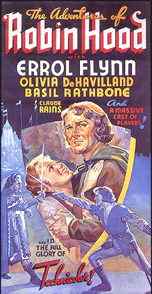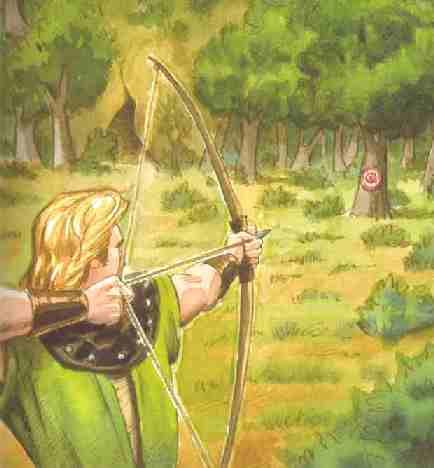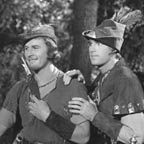|
ROBIN HOOD - The Famous English Outlaw
|
||||||||||||||||||||||||||||||||||||||||||||||||||||||||
|
HOME | BIOLOGY | FILMS | GEOGRAPHY | HISTORY | INDEX | MUSIC | SOLAR BOATS | SPORT | SPONSORS |
||||||||||||||||||||||||||||||||||||||||||||||||||||||||
|
Robin Hood is the archetypal English folk hero, an outlaw who, in modern versions of the legend, stole from the rich to give to the poor. This redistributionist form of philosophy-in-action anticipates the work of writers such as Proudhon and Karl Marx by many hundreds of years. Although most noted for his material egalitarianism, in the stories he also pursues other types of equality and justice. However, as outlined later, Robin Hood was not originally portrayed as generous.
There are several great films about the mythical hero, two of which are my personal favorites:-
"The Adventures of Robin Hood", 1938 FILM
Errol Flynn and Oliva DeHaviland
Directed
by Michael Curtiz
William Keighley Genre:
Action / Adventure
/ Romance
The other film is the more recent adaptation starring Kevin Costner and Morgan Freeman. This one is more earthy with several bloody action scenes and special effects to enhance the viewing experience.
Kevin Costner & Morgan Freeman
Career of the Robin Hood legendThe stories relating to Robin Hood are apocryphal, verging on the mythological. His first appearance in a manuscript is in William Langland's Piers Plowman (1377) in which Sloth, the lazy priest boasts "I ken (i.e. 'know') 'rimes of Robin Hood." Three years later the Scottish chronicler John Fordun writes that, in ballads, "Robin Hood delights above all others". Printed versions of Robin Hood ballads appear in the early 16th century -- shortly after the advent of printing in England. In these ballads, Robin Hood is a yeoman which, by that time, meant an independent tradesman or farmer. It is only in the late 16th century that he becomes a nobleman, the Earl of Huntington, Robert of Locksley, or later still, Robert Fitz Ooth. His romantic attachment to Maid Marian (or "Marion") (originally known as Mathilda) is also a product of this later period and probably has something to do with the French pastoral play of about 1280, the Jeu de Robin et Marion. Aside from the names there is no recognizable Robin Hood connection to the play. The late 16th century is also the period when the Robin Hood story is moved back in time to the 1190s, when King Richard is away at the crusades. One of the original Robin Hood ballads refers to King Edward (Edward I, II, and III ruled England from 1272 to 1377). The idea of Robin Hood as a high-minded Saxon fighting Norman Lords originates in the 19th century, most notably in the part Robin Hood plays in Sir Walter Scott's Ivanhoe (1819), chapters 40 - 41, where the familiar modern Robin Hoodó "King of Outlaws and prince of good fellows!" Richard the Lionhearted calls himó makes his debut. The folkloric Robin Hood was deprived of his lands by the villainous Sheriff of Nottingham and became an outlaw. The Sheriff does indeed appear in the early ballads (Robin kills and beheads him), but there is nothing as specific as this allegation. Robin's other enemies include the rich abbots of the Catholic Church and a bounty hunter named Guy of Gisbourne. Robin kills and beheads him as well. The early ballads contain nothing about giving to the poor although Robin does make a large loan to an unfortunate knight.
The Sheriff used all the powers at his disposal and hounded Robin and his merry men. Significant rewards were posted, but nobody turned Robin in because they knew he was not a bad man. In fact, the money he robbed from the rich, he gave to the poor. Robin fought to obtain justice. If you are having a planning problem and your local authority (Council = Sheriff) is after you, then Robin Hood's story may sound familiar and just a bit more like life in England today. The point we are making here is that if we band together to fight injustice, we stand a better chance.
In the ballads, the original "Merry Men" (though not called that) included: Friar Tuck, Will Scarlet or Scathlock, Much the Miller's Son, and Little John -- who was called "little" because he wasn't. Alan-a-Dale is a later invention in Robin Hood plays.
Classic Robin Hood - Archery Contest
Possible locationsIn modern versions of the legend, Robin Hood is said to have taken up residence in the verdant Sherwood Forest in the county of Nottinghamshire. This is a matter of some considerable contention. The original ballads speak of his being in Barnsdale (the area between Pontefract and Doncaster), some fifty miles north of Sherwood in the county of Yorkshire, and this is reinforced for some by the similarity of Locksley to the area of Loxley in Sheffield. In fact, there is a something of a modern movement amongst Yorkshire residents to try to reappropriate the legend of Robin Hood, to the extent that South Yorkshire's new airport, on the site of the redeveloped RAF Finningley airbase near Doncaster, will be given the name Robin Hood Airport Doncaster Sheffield. This debate is hardly surprising, given the considerable value that the Robin Hood legend has to local tourist industries. Indeed, one of Nottinghamshire's biggest tourist attractions is the Major Oak, a tree that according to local folklore was the home of the legendary outlaw. It is also argued that had Robin been based in Yorkshire, he would have had nothing to do with the Sheriff of Nottingham who operated two days ride to the south. Modern interpretationsSongs, plays, games, and, later, novels, musicals, films, and tv series have developed Robin Hood and company according to the needs of their times, and the mythos has been subject to extensive ideological manipulation. Maid Marian, for instance, something of a warrior maiden in early Victorian novels was reduced in demeanour to passivity during the period of the women's suffrage movement. As the media power of the modern feminist movement gathered momentum, Marian reacquired an altogether more active role. Robin Hood himself has been transformed from a bandit with an occasional element of generosity in the original tales, to the contemporary reading, where he is depicted more as a medieval Che Guevara leading a small rebel force fighting a guerrilla war against Prince John and the Sheriff on behalf of the oppressed and King Richard I.
Robin Hood, also known as Robin of Loxley, returned to England to find his father murdered and his estate forfeit. The evil Sheriff of Nottingham has conspired with other landowners to usurp the crown of Richard the Lion Heart. Robin formed a band of men dedicated to resisting the Sheriff. They lived in Sherwood Forest and were declared outlaws.
Robin Hood and Will Scarlet
Robin
of Sherwood
Douglas Fairbanks in Robin Hood The Adventures of Robin Hood at Filmsite The New Adventures of Robin Hood Robin Hood -- The Legend of Sherwood A Fancyfull Historie of That Most Notable & Fameous Outlaw Robyn Hood
Robin Hood Country
Touring Robin Hood's Nottinghamshire on Britannia Touring Robin Hood's Yorkshire on Britannia The Legend of Robin Hood by Richard Rutherford-Moore Robin Hood -- The Yorkshire Connection Robin Hood -- Bold Outlaw from Loxley The World Wide Robin Hood Society A Guide to Robin Hood and Northern England
Robin Hoods of the World
Robin Hood is often considered the archetypal outlaw hero. As a result, many cultural heroes are referred to as the Robin Hoods of their respective countries. These sites are about Robin Hood-like characters. Unlike Robin Hood, those below are entirely real legends, but equally as gallant in their own right.
Ned Kelly: Australian Iron Outlaw
Robin Hood Booklist
This is a reading list involving the Robin Hood legend. ∑ Medieval Fiction: often published at any point in time, but discussing texts from this period. I've arbitrarily put everything pre 1600 in this section, although I realize this isn't the "medieval" period.
Robin Hood - Airfix Kit
Other Online Resources
Here are some online resources that readers have sent in: The Robin Hood Text Archive The Robin Hood Project, The University of Rochester
GENERAL HISTORY LINKS
MARITIME HISTORY
A taste for adventure capitalists
Solar Cola - a healthier alternative
|
||||||||||||||||||||||||||||||||||||||||||||||||||||||||
|
This
website
is Copyright © 1999 & 2076 NJK. The bird The name '1824' is a trade mark of Solar Cola Ltd. All rights reserved. Max Energy Limited is an educational charity. |
||||||||||||||||||||||||||||||||||||||||||||||||||||||||
|
AUTOMOTIVE | BLUEBIRD | ELECTRIC CARS | ELECTRIC CYCLES | SOLAR CARS |
||||||||||||||||||||||||||||||||||||||||||||||||||||||||



